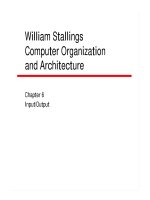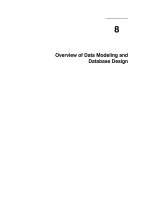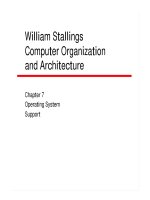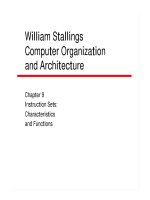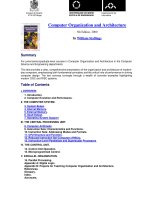Tài liệu William Stallings Computer Organization and Architecture P6 pptx
Bạn đang xem bản rút gọn của tài liệu. Xem và tải ngay bản đầy đủ của tài liệu tại đây (998.51 KB, 40 trang )
William Stallings
Computer Organization
and Architecture
Chapter 11
CPU Structure
and Function
CPU Structure
§ CPU must:
• Fetch instructions
• Interpret instructions
• Fetch data
• Process data
• Write data
Registers
§ CPU must have some working space (temporary storage)
§ Called registers
§ Number and function vary between processor designs
§ One of the major design decisions
§ Top level of memory hierarchy
User Visible Registers
§ General Purpose
§ Data
§ Address
§ Condition Codes
General Purpose Registers (1)
§ May be true general purpose
§ May be restricted
§ May be used for data or addressing
§ Data
• Accumulator
§ Addressing
• Segment
General Purpose Registers (2)
§ Make them general purpose
• Increase flexibility and programmer options
• Increase instruction size & complexity
§ Make them specialized
• Smaller (faster) instructions
• Less flexibility
How Many GP Registers?
§ Between 8 - 32
§ Fewer = more memory references
§ More does not reduce memory references and takes up processor
real estate
§ See also RISC
How big?
§ Large enough to hold full address
§ Large enough to hold full word
§ Often possible to combine two data registers
• C programming
• double int a;
• long int a;
Condition Code Registers
§ Sets of individual bits
• e.g. result of last operation was zero
§ Can be read (implicitly) by programs
• e.g. Jump if zero
§ Can not (usually) be set by programs
Control & Status Registers
§ Program Counter
§ Instruction Decoding Register
§ Memory Address Register
§ Memory Buffer Register
§ Revision: what do these all do?
Program Status Word
§ A set of bits
§ Includes Condition Codes
§ Sign of last result
§ Zero
§ Carry
§ Equal
§ Overflow
§ Interrupt enable/disable
§ Supervisor
Supervisor Mode
§ Intel ring zero
§ Kernel mode
§ Allows privileged instructions to execute
§ Used by operating system
§ Not available to user programs
Other Registers
§ May have registers pointing to:
• Process control blocks (see O/S)
• Interrupt Vectors (see O/S)
§ N.B. CPU design and operating system design are closely linked
Example Register
Organizations
Foreground Reading
§ Stallings Chapter 11
§ Manufacturer web sites & specs
Instruction Cycle
§ Revision
§ Stallings Chapter 3
